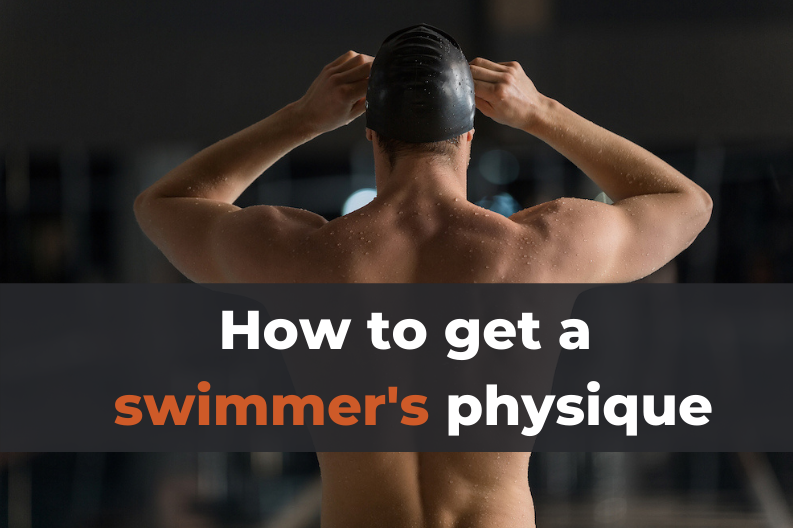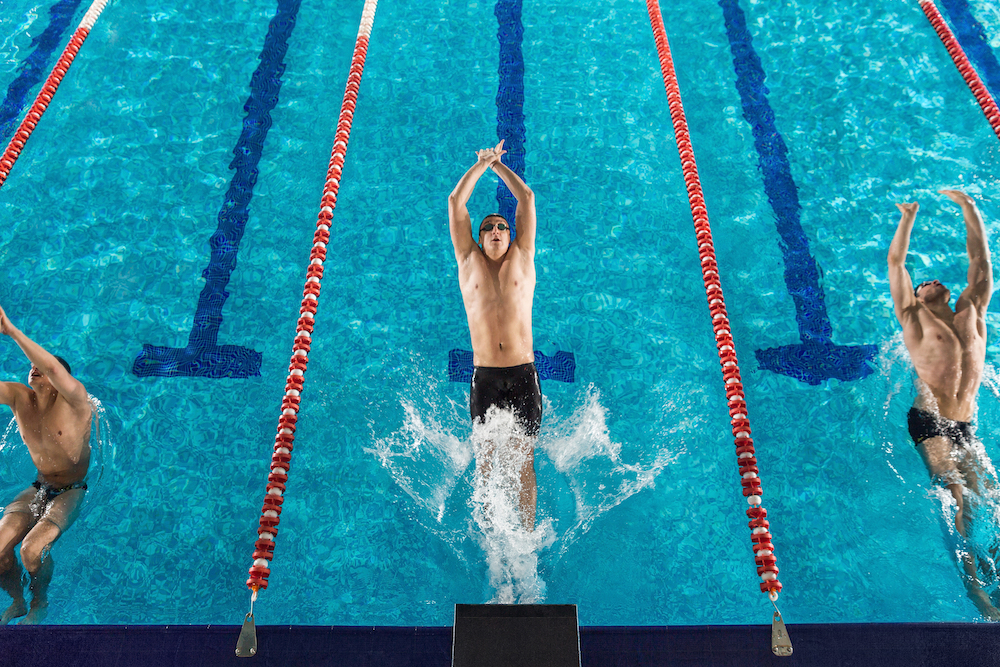A swimmer’s body is one of the most popular and sought-after athletic body types, and for good reason.
Michael Phelps or Ryan Lochte, anyone?
It combines an attractive physique with incredible endurance and performance — it’s also a great middle ground between bulky and skinny.
So how do you get a body like a swimmer?

A swimmer’s body is long and lean, with a broad and powerful back and extremely low levels of body fat.
To get a swimmer’s physique, you’ll need to swim frequently (shocker!) and dial in your nutrition — this will help you bring out the visible abs of a swimmer. Supplement your swimming with strength training specifically targeting your back, abs, and legs.
Let’s take a closer look with the help of some personal trainers.
What Are the Hallmarks of the Swimmers Physique?
A swimmer’s physique has obvious wide lats and toned triceps along with visibly strong legs, and abs.
The muscles there are strong, but they’re not flashy or overly bulky.
This look is usually found on a body that’s slim overall with very little body fat, and no thick muscle.
You’ll occasionally find a more muscular swimmer, but that person usually does activities outside of swimming and isn’t coveting a specific swimmer’s body look.
Regardless of the exact appearance at any given time, a swimmer’s body is usually highly resistant and can withstand exercise for long periods of time.

Meanwhile, inside, swimmers have powerful lungs and can keep up activities without feeling too breathless.
The lungs come with building strength and stamina in the rest of your body.
A combination of simple strength and stamina makes up the main functions of the physique.
6 Training Tips for a Swimmer’s Body
There are a few ways you can start not only building the aesthetic but the actual function of a swimmer’s body.
Seeing results may take some time, but if you stick with it, you can achieve the look you covet.
#1. Dial in Your Nutrition
Several coaches point out that swimmers are typically slim, lacking extra body fat.
To achieve the same look, you’ll want to bring your body fat percentage low enough for sharp, visible abs.
This not only helps show off the muscle definition but it lets them cut through the water faster, too.
For people with only a little body fat you won’t have much work to do to lose it—swimming is an excellent calorie burner, and the supplementary training will work too.
Heavier people can also try different strokes and techniques to help them lose weight.
Regardless of your body size, eating right to maintain the swimmer’s figure is a definite must.
Cut out empty carbs, processed foods, and excessive fat and sugar.
That’ll keep your calories down and leave you with more filling, nutritious options.
As for specific foods you should consume to obtain and maintain a swimmer’s body, Andy Brown, wellness coach, has a few recommendations:
- Salmon
- Cod
- Ground turkey
- Lots of water
- Kale
- Spinach
- Sweet potatoes
- Quinoa
- Steel-cut oatmeal
If you have any other lean proteins, antioxidant vegetables, and complex carbs similar to the ones above that you like, work those in as well.
#2. Swim, Swim, Swim
You can’t get a swimmer’s body without jumping into the water, so dive in!
Try swimming lengths for a while, and if you’re a beginner, stick to the shallower water.
Graduate to the deep end as you gain confidence in the water.
While in the pool there are lots of ways you could start building up that body—there are no hard and fast rules with swimming, unless you’re competitive.
Do lengths, widths, laps, whatever you feel most comfortable with.
You should also vary your speed, as the faster you go the more resistance there is.
Try to swim for at least 20 minutes at a time, three times a week, and consider building this up to 30 minutes as you build your stamina.
It’ll be difficult at first, you’ll feel your muscles aching during and after your time in the pool, but that just means you’re making progress.
#3. Build Flexibility
One reason you may ache after a swim is that your body isn’t used to working that way.
Swimming utilizes a lot of motion in the shoulders, so try working on flexibility overall to get your body used to bending and working in new ways and shapes.
Andy Brown recommends three things to work on your flexibility, and holds them in equal importance with nutrition and strength training.
Yoga
Yoga may seem like a waste of time if you want a swimmer’s physique, but you’ll find it’s an excellent workout and terrific at promoting your flexibility and mobility.
Where at the start, your shoulders might not move smoothly all the way around the joint, you’ll notice improvement after regularly practicing yoga for a month or so.
Foam Rolling
Foam rolling works well when paired with yoga.
It’s used to release your muscles and stop them from tightening up, so they work better for you during intense activity.
You should particularly focus on your back and leg muscles, as they’re highly engaged in swimming.
The hamstrings are one to give extra attention—hamstring injuries may sound more like a runner’s burden, but with all that kicking you’re doing, you should be just as mindful as any runner.
Mobility Work
Like in yoga, mobility work is helpful for opening up those joints.
Yoga poses and stretches will focus on the actual opening part—increasing how much you can widen your hips, stretch your shoulders out and so on.
The mobility work will help smoothen those movements.
Andy Brown recommends:
- Clamshells
- Birddogs
- Shoulder elevation
- Shoulder depression
If you have the time, try an occasional pilates or barre class for some enjoyable strength and mobility work.
#4. Strength Training
Andy also recommends strength training, which may not sound productive for a swimmer.
You want stamina, not bulk — but if you weight train properly, you can build both lean muscle and, more importantly, muscular endurance.
This will keep your arms, legs, and back from giving out on your halfway across the pool.
So, get in that weight room and start working on the key muscle groups used in swimming:
- abs
- lats
- legs
- and triceps.
Here are the exercises that personal trainer Andy recommends:
- Dumbell upright rows
- Single-arm rows
- Banded shoulder pull-aparts
- Dumbbell or kettlebell deadlifts
- Dumbbell or kettlebell goblet squats
He also recommends that you do frequent pushups, be it regular or on your knees.
With all of these exercises, it’s important to note that it’s not the amount of weight you can handle, but the number of reps.
You want endurance, not brute strength, so whenever you feel like you’ve “mastered” lifting a certain weight, don’t increase it — add in more reps, more sets, or decrease your rest intervals.
#5. Complimentary Exercises
For the swimmer’s physique, you’ll want to give some extra attention to your back muscles using complimentary exercises.
Simon Slavssen, assistant profession of preventive medicine, has some recommendations.
For complimentary exercises, he suggests you consider:
- Lat pulldowns
- Rowing
- Crunch presses
These are all fantastic for working on your back muscles and broadening your shoulders, but the latter two also help build a powerful core.
Simon states that these will help you get that desireable V-shaped swimmer’s physique much faster than if you neglected them.
#6. Incorporate Calisthenics
Finally, Dr. Ahmed Zayed recommends calisthenics for anyone trying to get a body like a professional or Olympic swimmer.
He says that calisthenics is excellent for your upper body strength and building strength and endurance.
He also mentions that calisthenics exercises are surprisingly great for your legs.
If you’re a total beginner and don’t know what calisthenics actually is, here are the basics:
It’s a form of strength training that usually utilizes only your bodyweight — although weights can be added to increase difficulty.
For simple, no-equipment calisthenics, you can also work on:
- squats
- lunges
- planks
- crunches
…and the rest of those classic exercises that you’ll also find in HIIT and other workouts.
These exercises are safe for most folks to perform regularly, even on rest days — just don’t leave yourself so sore that you won’t be able to swim the next day!
Wrapping Up
With a lot of hard work in and out of the pool, you can splash and lift your way to a swimmer’s body.
Focus on those back and arm muscles as well as strengthening your legs, and always look for ways that you can build stamina rather than bulking up your muscles.
With some simple calisthenics and yoga at home — and a few days per week at the gym swimming and strength training — you should be well on your way to that broad-shouldered, v-shaped swimmer’s physique.
Before you go, don’t miss:
Hope this helps!